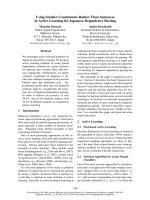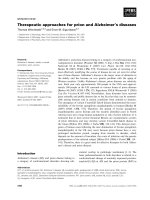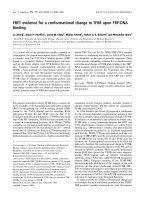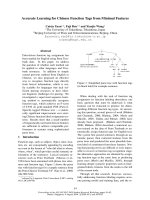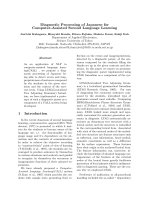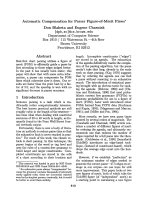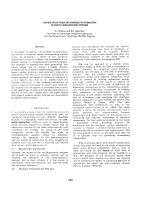Báo cáo khoa học: "Lexicon Features for Japanese Syntactic Analysis in Mu-Project-JE" pot
Bạn đang xem bản rút gọn của tài liệu. Xem và tải ngay bản đầy đủ của tài liệu tại đây (459.12 KB, 6 trang )
Lexicon Features for Japanese Syntactic Analysis in Mu-Project-JE
Yoshiyuki Sakamoto
Electrotechnical
Laboratory
Sakura-mura,
Niihari-gun,
Ibsraki, Japan
Masayuki Satoh
The
Japan
Information
Center
of
Science and
Technology
Nagata-cho, Chiyeda-ku
Tokyo,
Japan
Tetsuya Ishikawa
Univ. of
Library
&
Information Science
Yatabe-machio
Tsukuba-gun.
Ibaraki, Japan
O.
Abstract
In this paper, we focus on the features of a
lexicon for Japanese syntactic analysis in
Japanese-to-English translation. Japanese word
order is almost unrestricted and
Kc~uio-~ti
(postpositional case particle) is an important
device which acts as the case label(case
marker)
in Japanese sentences. Therefore case grammar is
the most effective grammar for Japanese syntactic
analysis.
The case frame governed by )buc~n and having
surface
case(Kakuio-shi),
deep case(case label)
and semantic markers for nouns is analyzed here to
illustrate how we apply case grammar to Japanese
syntactic analysis in our system.
The parts of speech are classified into 58
sub-categories.
We analyze semantic features for nouns and
pronouns classified into sub-categories and we
present a system for semantic markers. Lexicon
formats for syntactic and semantic features are
composed of different features classified by part
of speech.
As this system uses LISP as the programming
language, the lexicons are written as S-expression
in LISP. punched onto tapes, and stored as files
in the computer.
l.
Introductign
The Mu-project is a national project
supported by the STA(Science and Technology
Agency), the full name of which is "Research on a
Machine Translation System(Japanese - English> for
Scientific and Technological Documents.'~
We are currently restricting the domain of
translation to abstract papers in scientific and
technological fields. The system is based on a
transfer approach and consist of three phases:
analysis, transfer andgeneration.
In the first phase of machine translation.
analysis, morphological analysis divides the
sentence into lexical items and then proceeds with
semantic analysis on the basis of case grammar in
Japanese. In the second phase, transfer, lexical
features are transferred and at the same time, the
syntactic
structures
are also transferred by
matching tree pattern from Japanese to English, In
the final generation phase, we generate the
syntactic structures and the morphological
features
in English.
2.
Coac_~pt of_~_Deoendencv Structure based
on
Case Gramma[_/n Jap_a_D~
In Japan, we have come to the conclusion that
case grammar is most suitable grammar for Japanese
syntactic analysis for machine translation
systems. This type of grammar had been proposed
and studied by Japanese linguists before
Fillmore's presentation.
As word order is heavily restricted in
English syntax, ATNG~Augmented Transition Network
Grammar) based on CFG~Context Free Grammar ) is
adequate for syntactic analysis in English. On the
other
hand,
Japanese word order is almost
unrestricted and
K~l!,jlio shi
play an important role
as case labels in Japanese sentences. Therefore
case grammar is the most effective grammar for
Japanese syntactic analysis.
In Japanese syntactic structure, the word
order is free except for a predicate(verb or verb
phrase) located at the end of a sentence. In case
grammar,
the verb plays a very important role
during syntactic analysis, and the other parts of
speech only perform in partnership with, and
equally subordinate to. the verb.
That is. syntactic analysis proceeds by
checking the semantic compatibility between verb
and nouns. Consequently. the semantic structure of
a sentence can be extracted at the same time as
syntactic analysis.
3. __ca.$_e_Er
ame
.~oYer
n~ed
by_
J:hu~/C_ll
The case frame governed by !_bAag_<tn and having
l~/_~Luio:~hi, case label and semantic markers for"
nouns is analyzed here to illustrate how we apply
case grmlmlar to Japanese syntactic analysis in our
system.
}i~ff.TCil consists of vet b.
~'~9ou _.s'hi
~adjec:tive
and
L<Cigo~!d()!#_mh~
adjectival
noun L~bkujo
,~hi
include inner case and outer'
case markers in Japanese syntax. But a single
Iqol,'ujo
~/l; corresi:~ond.~ to several deep cases: for
instance, ".\'I" indicates more than ten case labels
including SPAce. Sp~:ee TO. TIMe, ROl,e, MARu,-:I .
GOAl. PARtr,cu'. COl'~i,or~ent. CONdition.
9ANge
We analyze re]atioP,<; br:twu,::n
[<~,kuj~, ,>hi
anH cas,:,
labels
and wr.i i,c thcii~ out, manu~,l]y acc,.:,idii~,
t,:,
the ex~_m,;:]e.s fotmd o;;t ill samr, te texts.
* This project is being carried out with the aid of a specia], gro~H for the promotion of scien,:.c ah,!
technology from the Science and Techno]ogy Agency of the Japane:ze GovoYf~: ~,t.
42
As a result of categorizing deep cases, 33
Japanese case labels have been determined as shown
in Table I.
T~_bi~_ !~__Ca_s~_Lahe~._fo_~_Ve~bal_Ca_se~_rames
English Label Examples
~~-
1980 ~£(c
~[T~n. ~9, %99,,5
• ~;, ~)] I~.
10 m/sec. "C
.~ ~,a~ -~ ~ ,5
~ < 9 ~ ,~',
- lr r~] b-u
Japanese Label
(2) ";H~ OBJec~
(3) ~-~- RECipient
(4l ~-Z.~
ORigin
(5)
~.~- i PARmer
(6) ~-~
2 OPPonent
{7) 8-~ TIMe
(8)" ~
•
~i%,~,,
Time-FRom
(9)
B@ •
~.~.,~, Time-TO
leO) ~
DURatmn
(l
I
) L~p)~ SPAce
02) ~
•
~.,~,, Space-FRom
(13) h~ • $~.,~., Space-TO
(14") hP~
- ~
Space-THrough
(15) ~Z~ ~.~, SOUrce
(16) ~,~,~. GOAl
(17) [~
ATTribute
(18) ~.{:~
• iz~
CAUse
(19) ~ • ii~. ~. TOO~
(20)
$~
MATerial
(21) f~ ~- '~
COMponent
(22)
7]~
MANner
(23) ~= CONdition
(24) ~] ~ PURPOse
(25)
{~J
ROLe
(26) [-~ ~ ~.~
COnTent
(27) i~ [~l ~. ~ RANge
(28) ~ TOPic
(29) [Lg ~,, VIEwpoint
(30) ,L'~ tt~
COmpaRison
(32) ~
DEGree 5%~/~-@. 3 ~0@-~/-,5
(33l P~]~ '~
PREdicative ~ "~,.~ 8
Note:
The capitalized letters form
English acronym for that case label.
the
When semantic markers are recorded for nouns
in the verbal case frames, each noun appearing in
relation to
l/2u(~'n
and
Kclkuio-shi
in the sample
text is
referred
to the noun lexicon.
The process of describing these case frames
for lexicon entry are given in Figure ].
For each
verb,
l<ctkuio-Mtt
and
Keiuoudoi~-_.shi,
Koktuo-shi and case labels able to accompany the
verb are described, and the semantic marker for
the noun which exist antecedent to that
Kokuio-shL
are described.
4.
Sub-cat~or_ies of Parts of SDeech
accordiDg to their Syntactic Features
The parts of speech are classified into
13
main categories:
nouns, pronouns, numerals, affixes, adverbs.
verbs.
~eiy_ou ~h~. Ke~uoudou-shi.
Renlcli-shii~adnoun),
conjunctions, auxiliary verbs,
markers and ./o~shi(postpositional particles;. Each
category is sub-classified and divided into 56
sub-categories(see Appendix A); those which are
mainly based on syntactic features, and
additionally on semantic features.
For example, nouns are divided into 11
sub-categories; proper nouns, common nouns, action
nouns I
(S~!tC~! ~jc i sh i ),
action nouns
2
(others
}.
adverbial nouns.
~bk:±tio-shi-teki-i,~ishi
(noun
with
case feature
~,
~l~:okuio-shi-teki-i~i~hi
(noun
with conjunction feature), unknown nouns,
mathematical expressions, special symbols and
complementizers. Action nouns are classified into
,~lhc(~-mc'ishi
ia noun that can be a
noun-plus-St~U,,doing> composite verb) and other
verbal nouns, because action noun ] is also used
as the word stem of a verb.
Identify taigee-buusetsu
I
(substantive phrase)
I
governed
by yougen J
active
vo
Other thau active voice
converted to
active
.,[
~ephce
kakarijo-sh~('~A'. /
'NOMISHIKA', 'NO', 'NO')wit~
kaku~o-nhi
[
voice
*ACTIVE, PASSIVE, CAUSATIVK POTENTIAL
[TEkREJ
>.'y :e ,~= ~, ~.':, 9 "-~8
ffi I~'~,DII~) ¢.,~1= J: 8t¢
~T~.
NG
'[ Fill kakujo-shi enteceden~
noun for verb phrase
|
in relative clause
}
{
I ,.°__o.o.=,,, t
l
i
i
Coustruct
case
frue
forset
J
]
f~- F-~ ~'~' ~- ~'l:
E~gure_._ ! Bho~_.k~___Dia_gr_am of Pro~ess___o f
[~s_c_rJ._b_in~Yerb_al .Case Frames_
43
Adverbs are divided into 4 sub-categories for
modality , aspect and tense. In Japanese, the
adverb agrees with the auxiliary verb.
C~in~utsu-futu-shi
agrees with aspect, tense
and mood features of specific auxiliary verb,
Joukuou-fz~u-shi
agrees with aspect and
tense,
Teido-fuku-shi
agrees with gradability.
Auxiliary verbs are divided into
5
sub-catagories based on modality, aspect, voice,
cleft sentence and others.
Verbs may be classified according to their
case frames and therefore it is not necessary to
sub-classify their sub-categories.
5. Semantic Markimz of Nouna
We analyze semantic features, and assign
semantic markers to Japanese words classified as
nouns and pronouns. Each word can give five
possible semantic markers.
The system of semantic markers for nouns is
made up of tO conceptual facets based on 44
semantic slots, and 38 plural filial slots at the
end (see Figure 2 ).
I,~ ~ ' [~3 N. J~l • ~1~ • O (Natiom-Organ|Zatlo.)
(Thing.
/ '='" =,.t)I
(PLant) (~nilet)
(¢nanlsate I r (NaturaL)
(~'tlfl¢laL)
(~lty
-Mare)
I J-~ J~J'll~. (Hlterfat)
CP 14:"t~b.4:'i'~4~ (Product)
5.1 Concept of semantic markers
The tO conceptual facets are listed below.
I) Thing or Object
This conceptual facet contains things and
objects; that is, actual concrete matter. This
facet consists of such semantic slots as
Nation/Organization, Animate object, Inanimate
object, etc.
2) Commodity or Ware
This conceptual facet contains commodity and
wares; that is, artificial matter useful to
humans. This facet consists of such semantic slots
as Material. Means/Equipment,
Product.
etc.
3) Idea or Abstraction
This conceptual facet contains ideas and
abstractions: that is. non-matter as the result of
intellectual activity in the human brain. This
facet contsists of such semantic slots as Theory,
Conceptual object. Sign/Symbol, etc.
4) Part
This conceptual facet contains parts: that
is, structural parts, elements and contents of
things and matter.
PA tA.Z~lf~.~li(~-tfffcl|L PMnoB¢~
.Em~ilemt )
(Social I
,~ (Pot I t Ica t -Eco~liclt )
(~tom-SO¢| ~L COmamt Ion)
(Po~r -Ener~w. Physl ca t ObjKt)
(Doing. t
~¢tlo.) ~,OH I~@. ~ (~t-Roaction)
/
L~ OE t~-
~
(Effect-O~eratfo~)
(]du.
~=tract 1o.)
~4e~ • ~ - ~11 - ~ (mlery)
~D. ~ (Slgn-SxW~ot)
(Sentllent • I',
HentlL ~¢tfulty)~,~ (Emotion)
ST j~l~. ~lJ (Recognition-Thought)
(Part)
(Attrl~te)
~ m@ (Part)
• t " ~ (ELlee.t-Contemt)
~
~1 (Property-Character t st Ic)
)Bt~ ~ AF i]BS (For=.S~tpe)
(Status- I ' '
Figure) ~ ~C [:h~lB (State-Cofldftion)
Figu~
2,
Sy.a_t~m__of
~
Wl , ~ ]1~ (Nu=her)
I,
(l~alure) ~-~ HU ]Jll~. RJ~ (Unit)
I,
[-I,-~1~= • aim (standard)
• l TO I~ I ! T$ II~J~f" ~f~" ~h~. (Space-Topography)
(Tile-SPace) I
~'~1~-~1 I TP 'iB~J~ (Tile Point)
(Tile)
/
TO ~l~mm u (Tile Ouration)
I' J
TA ,1~ (Tile Attrtbute~
Sem~nt~g__M~r ke~a_fo r
_Np_u ns
44
5 Attribute
This conceptual facet contains attributes:
that is, properties, qualities
or
features
representative of things. This facet consists of
semantic slots such as Property Characteristic.
Status Figure, Relation, Structure, etc.
6 Phenomenon
This conceptual facet contains phenomena:
that is, physical, chemical and social actions
without human activity. This facet consists of
semantic slots such as Natural phenomenon,
Artificial phenomenon Experiment. Social
phenomenon, Power Energy, etc.
7, Doing or Action
This conceptual facet contains human doing
and actions. This facet consists of such semantic
slots as Action Deed. MovementReaction,
Effect Operation, etc.
8: Mental activity
This conceptual facet contains operations of
the mind and mental process. This facet consists
of semantic slots such as Perception. Emotion.
RecognitionThought, etc.
9.!
Measure
This conceptual facet contains measure: that
is, the extent, quantity, amount or degree of a
thing. This facet consists of semantic slots such
as Number. Unit, Standard, etc.
10i Time and Space
This conceptual facet contains space,
topography and time.
5.2
Process of semantic marking
The semantic marker for each
word
is
determined
by
the following steps.
1) Determine the definition and features of a
word. 2, Extract semantic elements from the word.
3) Judge the agreement between a semantical slot
concept and extracted semantical element word by
word, and attach the
corresponding
semantic
markers. 4; As a result, one word may have many
semantic markers. However, the number of semantic
markers for one word is restricted to five. If
there are plural filial slots at the end. the
higher family slot is used for semantic
featurization of the word.
It is easy to decide semantic markers for
technical and specific words. But, it is not easy
to mark common words, because one word has many
meanings.
~ __Lexicon Z_Qr na,t .f_o_r. _$yn_tactic_ Ana!ys_is
Lexicon formats for syntactic and semantic
features are composed of different features
classified by part of speech.
I >
Features of verb:
Subject code: verb used in specific field.
only electrical in our experiment
Part of speech in syntax: verb
Verb pattern: classifing the verbal case
frame, a categorized marker
like
Hu{nby's case
pattern is planned to be used.
Entry to lexieal unit of transfe~ lexicon
Aspect: stative, semi-stative, continuative,
resultative, momentary
or
progressive/transitive
Voice: passive, potential, causative or
"7~l~RU'<perfective/stative)
Volition; volitive, semi-volitive or
volitionless
Case frame: surface case, deep case, semantic
marker for noun and inner-outer case
classification
Idiomatic usage: to accompany the verb(ex.
catch a cold> syntax, verb pattern,
2i Features of Keillo~t-$h~ and lieiuoudou-shi:
both syntactic features are described in
almost the same format.
Sub-category of part of speech; emotional,
property, stative or relative
Gradability: measurability and polarity
Nounness grade: nounness grade for
Keiuou-shi!++. +, -, )
3) Features of noun: sub-category of
nounCproper, common, action, adverbial, etc),
lexical unit for transfer lexicon, semantic
markers, thesaurus code, and usage.
4) Features of adverb: sub-category of
adverb(/ouk~, Teido,
(~2~iaiufSU,
S~mr~10~¢)
considering modality, aspect, tense and
gradability
5)
Features of other taigen:
sub-category
of
Rcnluj_z~hi(
demonstrative, interrogative,
definitive, or adjectival) and conjunction(phrase
or sentence
6i Features of/~k~l=~L*i(auxiliary verb):
Jodo~=%bi are sub
classified
by sub-category
on semantic feature:
Modality~negation, necessity, suggestion,
prohibition )
Aspect~past. perfect, perfective stative,
progressive, continuative, finishing,
experiential )
Voice(passive
or
causative)
Cleft sentence(purpose and reason>
etc('T~WlRlr . "TENISEI~U" , "TEOhLi" , "SOKQ\;Ri"
and "TEII@2~U" )
7} Features of /9n$lli:
Subcategory of /~==5~.(: case, conjunctive,
adverbial, collateral final or 2_Ill~li
Case: features of surface case(ex.
"Gd" "I¢0"
"NI' "TO'. ),
modified relation~iu!!ui or
~B~o!t modification)
Conjunctive: sub-category of semantic
feature(cause/reason,
conditional/provisional,
accompanyment, time/place, purpose, collateral,
positive or negative conjunction, ere)
_7 , Data Base St.r_u._c.tur_e Qf~_h_e Lex, icon
As this system uses LISP as the programming
language, the lexicons are punched up as
45
S-expressions and input to computer files (see
Figure 3 ).
For the lexicon data base used for syntax
analysis, only the lexical items are hold in main
storage; syntactic and semantic features are
stored in VSAM random acess files on disk(see
Figure 4 ).
( cs~.,~at~ -v o o o ~ 5 o o- o z
-~
( $ R:~R fl,li
c s{~{~
64))
C Sg~::,- v
t~)
V]
( S Kea~ W)
(($~ M)
C$~JI~
SUB) ($~=-F OF OH) ($~4jl~ I))
v2
(s~
W)
(${~
,,~'-~ - )
(($~z~ ~() (s~JE~ SUB) c$~i~9~=-y OF OH) ($,~1~ 1))
( $ ~J~v60BJ)
(S~J~:-~' IT IC CO)
($~ PAR)
($~|~= v IT IC CO)
( $#Z~ O))))
V3
($I:~ W)
( $ ~3~J1111
(c$~ ~) ($~Im~ SUB) ($~=-~' OF OH) C$~11~ 1))
(($~I~ I:) ($~%~ REC) ($~J~= ~" xx) (S~4Ji~ 1)))
(S~flt~
¢$~,~
".~t~")))))
Figure 3. Lexicon File Format__in LISP
S-express " otoj~
Kn~ty-v~ct~r
~ia&er -li~t
o
] /~(OoO )
• 3 ~ MFR;mor~aol~cal feature
•
for
~ZtiOn
t~r¢l;
~Olmorm%ol~cal
f~we
for ~
for
~&~tio~ v(m'd
e~leom
for
syntactic am~lysLs
Fimure 4. Lexicon Data Base Structure for Analvsis
The head character of the lexical unit is
used as the record key for the hashing algorithm
to generate the addresses in the VSAM files.
8. con__cJJ~i_o_n
We have reached the opinion that it is
necessary to develop a way of allocating semantic
markers automatically to overcome the ambiguities
in word meaning confronting the human attempting
this task.
In the same thing, there are problems how to
find an English term corresponding to the Japanese
technical terms not stored in dictionary, how to
collect a large number of technical terms
effectively and to decide the length of compound
words, and how to edit this lexicon data base
easily, accurately, safely and speedily.
In lexicon development for a huge volume of
You(~n
, it is quite important that we have a way
of collecting automatically many usages of verbal
case frames, and we suppose it exist different
case frames in different domains.
Ackn_o_Ki~Lgm~_
We would like to thank Mrs. Mutsuko
Kimura(IBS~, Toyo information Systems Co. Ltd.,
Japan Convention Sorvice Co. Ltd., and the other
members of the Mu-projeet working group for the
useful discussions which led to many of the ideas
presented in this paper.
Rcf_c~.¢ng_e_a
(I) Nagao. M., Nishida, T. and Tsujii, J.:
Dealing with Incompleteness of Linguistic
Knowledge on Language Translation, COTING84,
Stanford, 1984.
(2) Tsujii. J., Nakamura, J. and Nagao, M.;
Analysis Grammar of Japanese for Mu-project.
COTING84.
{3) Nakamura. J Tsujii. J. and Nagao. M.:
Grammar
Writing Syst~n
(GRADE,
of Mu-Machine
Translation Project. COTING84.
(4; Nakai, H. and Satoh, M. : A Dictionary
with Taigen as its Core, Working Group Report of
Natural Language Processing in Information
Processing Society of Japan, WGNL 38 7, July,
1983.
(5 Nagao. M. ; Introduction to Mu Project.
WGNL 38 2, 1983.
6 Saka!roto. Y. : Yougcn and Fuzo'=:u- go
Lexicon in VerbJa! Case Frame. WGNL 38 8. 1983.
!7 ',. Sak~,r,!oLo. Y. : Japanese SyntaetLc Lexiccm
in Mu project. Proc. of 28th Conference of IPSJ,
1984.
'.8 Ishik~,~'._,, T., Sat,.>h. M. and Tal:aJ, S. :
SemantJ caI FulicLJ o:i on Natural [.~q~;S~ ~s, ~'
Processing, Proc. o.r" 28Lh CIPSJ. 1984.
46
Xi
r
£
U
n
0
CO
L
Z
~a
I~1 I w ~ ~ '
i~ ~i~ ~ 3 ,i
• m! .'- -
i-~l,
r
I
:1
t
o I i I
i m ~ 1
'~:t ~i: I ~ : f.: ® : : ~ a :i
l
||
l@
: E
"~i
~.~ ,~ I^ ~J~
~ ~ v1~ ~ ~ ~i ~ ~ ~ ~i ~ ~ ~ ~i~
I ~- ~ z i N i I
i@ E
E~ EE
47
